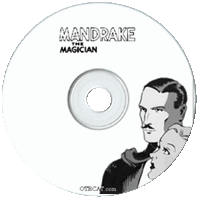

Juvenile Adventure series, many of Mandrake's foes were agents of Fascism and Nazism and he spent more time chasing saboteurs and submarines than we would expect for a stage magician.

32 old time radio show recordings
(total playtime 5 hours, 10 min)
available in the following formats:
1 MP3 CD
or
5 Audio CDs
Text on OTRCAT.com ©2001-2025 OTRCAT INC All Rights Reserved. Reproduction is prohibited.
Crime Fighting Serial (1940 - 42)
Maaa-nooo-Maaaandraaake-maaaa-nuuuuuu!

Unlike the Man of Steel and later costumed crime-fighters, Mandrake never had to rely on a secret identity, but he had plenty of super-powers, many of which came in handy for his "day job" as a stage magician. Both his act and much of his crime-fighting were based on an unusually fast hypnosis technique. By simply "gesturing hypnotically", Mandrake was able to make the audience and his enemies see what Mandrake wanted then to see.
Taking a cue from the Man of Steel, Mandrake the Magician was adapted for a Mutual Network series beginning in November 1940 (The Adventures of Superman began broadcast in February of the same year). Mandrake was played by Raymond Edward Johnson, who had developed his radio talents working with Arch Oboler on Lights Out and would go on to create the role of Raymond, the morbid horror host of Himan Brown's Inner Sanctum Mysteries.

Narda from the small European kingdom of Cockaigne (ruled benevolently by her brother Segrid). Narda was played by Francesca Lenni, but for a time stage actress Jessica Tandy filled the role.
The show ran until February 1942, with Mandrake and Lothar traveling the world, working magic, righting wrongs, and making the world a safer and better place.
Click here for more information about the comic pages in old time radio.
For more magical shows, see: Blackstone the Magician and The Magic Collection.
Text on OTRCAT.com ©2001-2025 OTRCAT INC All Rights Reserved. Reproduction is prohibited.
You have reached the maximum number of votes for a unregistered user.
Please login or create a new account to continue...
You have reached the maximum number to down votes in this page.



Mandrake the Magician Disc A001
|
Add Audio CD to Cart - $5.00 |
Mandrake the Magician Disc A002
|
Add Audio CD to Cart - $5.00 |
Mandrake the Magician Disc A003
|
Add Audio CD to Cart - $5.00 |
Mandrake the Magician Disc A004
|
Add Audio CD to Cart - $5.00 |
Mandrake the Magician Disc A005
|
Add Audio CD to Cart - $5.00 |
Please wait...
COMMENTS
Be the first to comment on "Mandrake the Magician"
Leave a comment